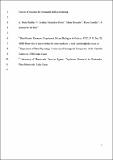Por favor, use este identificador para citar o enlazar a este item:
http://hdl.handle.net/10261/101979COMPARTIR / EXPORTAR:
 SHARE SHARE
 CORE
BASE CORE
BASE
|
|
| Visualizar otros formatos: MARC | Dublin Core | RDF | ORE | MODS | METS | DIDL | DATACITE | |

| Título: | Sources of variation for sustainable field pea breeding |
Autor: | Rodiño Míguez, Ana Paula CSIC ORCID; Hernández-Nistal, Josefina; Hermida, María; Santalla Ferradás, Marta CSIC ORCID ; Ron Pedreira, Antonio Miguel de | Palabras clave: | Animal feed Genetic improvement Germplasm Pisum sativum Seed protein |
Fecha de publicación: | mar-2009 | Editor: | Springer Nature | Citación: | Euphytica 166 (1): 95-107 (2009) | Resumen: | The pea crop (Pisum sativum L.) is a convenient source of plant protein for animal feeding. The objective of this research was to evaluate field pea breeding lines for agronomic performance and seed quality focussed to their use in a sustainable production. Thirty-five field pea breeding lines and six elite cultivars were evaluated for their agronomic value in field in Spain upon 20 traits related to flower, cycle, plant architecture, productivity and seed quality. The lines showed significant differences in all the quantitative traits evaluated and three of them, namely MB-0307, MB-0308, and MB-0319 were chosen to be evaluated, together with the advanced cultivar ZP-1233, in field and in growing chamber for agronomic performance, seed quality and ability for sustainable production. The four accessions displayed high seed protein content that had significant effect of cropping density with averages of 253.6 g kg−1 under low cropping density of 60 plants m−2 and 259.1 g kg−1 under high cropping density of 90 plants m−2, therefore, the low cropping density should be regarded as the most convenient. Average yield of the lines MB-0307, MB-0308 and MB-0319 and the cultivar ZP-1233 was fair (197.5 g m−2), probably due to the absence of fertilizers and irrigation, aiming for the sustainability of the crop. Intercropping with rye and herbicide application resulted in no differences on the seed yield; therefore, the ability of the breeding lines to grow without herbicide seems to be demonstrated, while the germination of the seeds at low temperature was very good. These results indicate that field pea could be a new protein crop in the North of Spain to satisfy the demand of plant protein for animal feed, based upon adapted breeding lines that combine the ability for growing under sustainable conditions with other desirable agronomic traits maintaining an adequate productivity | Versión del editor: | http://dx.doi.org/10.1007/s10681-008-9842-y | URI: | http://hdl.handle.net/10261/101979 | DOI: | 10.1007/s10681-008-9842-y | ISSN: | 0014-2336 | E-ISSN: | 1573-5060 |
| Aparece en las colecciones: | (MBG) Artículos |
Ficheros en este ítem:
| Fichero | Descripción | Tamaño | Formato | |
|---|---|---|---|---|
| Rodino_Sources_variation...pdf | 180,12 kB | Adobe PDF |  Visualizar/Abrir |
CORE Recommender
SCOPUSTM
Citations
10
checked on 21-abr-2024
WEB OF SCIENCETM
Citations
10
checked on 27-feb-2024
Page view(s)
357
checked on 24-abr-2024
Download(s)
311
checked on 24-abr-2024
Google ScholarTM
Check
Altmetric
Altmetric
NOTA: Los ítems de Digital.CSIC están protegidos por copyright, con todos los derechos reservados, a menos que se indique lo contrario.
